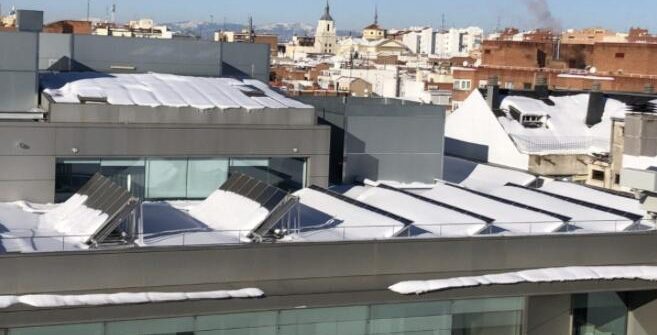Roof with solar panels in Madrid after the Storm Filomena.
Image: pv magazine/Alejandro Diego
Since January 8, approximately a third of the surface of Spain is covered in a dense, white blanket. It is not just “four flakes” or a few centimeters that will disappear in one day as on other occasions. This time, the snow is likely to cover the country for several days, due to the low temperatures and lack of rain.
This storm is going to have a significant impact on a multitude of photovoltaic plants located in communities like Castilla La Mancha, Madrid, Aragón and Castilla León and is, thus, raising a crucial question: How does snow affect PV performance?
The question is not new and there are already studies from the 1970s addressing the issue. In general, there is consensus that performance is affected, although it depends a lot on the orientation angle of the panels and the type of technology used.
System failures
According to a study published in 2013 by researchers at the University of Queens, the annual yield of crystalline solar panels in Southwest Ontario is reduced by up to 3.5% per year due to snow compared to a scenario in the same location without snow. In the opinion of experts dealing with this technology on a daily basis, such as Javier Asensio, CEO of Vector Renewables, a layer of only 3 or 4 centimeters of snow can make a conventional panel stop working completely. “If we add a cloudy sky to this, the performance is practically null or tending to irrelevance,” Asensio said.
According to Jesús Vega, a Spanish specialist in residential photovoltaics, although only a part of the panel is covered by snow and the rest is clean, it is usual for it to stop working completely. While standard solar modules are prepared for a common snowfall situation, as they usually include watertight compartments, problems can occur for various reasons. One of these is the poor calculation and design of the structures. In Vega’s opinion, if the extra weight of the panels is added to the effect of the wind, breaks and twisting of the structure can occur. “It is something that we have seen with the trees of the city of Madrid – the mixture of extra weight and wind can split the wood,” the expert said.
The same problem is corroborated by Javier Asensio from Vector. “I have personally seen mounting systems and trackers in the United Kingdom that have flown in times of snow and this can happen in Spain,” he said. “We believe that an independent audit of the manufacturers is necessary in the design of the photovoltaic structures.”
According to Jesús Vega, other components that can fail are the junction boxes and inverters due to excessive humidity. “In principle, the inverters must be covered and should have IP65 protection,” he said. “There are installers and electricians who are unaware of the particularities of solar and often there are problems in which water seeps into the junction boxes that can turn into ice in these cases.” For Vega, in especially humid or tropical locations, IP 66 even IP 67 protection would be recommended.
What technologies are more efficient in snowfall?
The bifacial module technology appears to be generating consensus within the industry regarding its efficiency. If we add snow to the usual increase in performance due to the albedo effect, bifacial panels seem the optimal choice for areas with regular ice, snow or hail. However, according to Asensio, the improvement with snow is not very noticeable if the direct exposure surface is covered. “In the best case we are talking about a 15% performance increase in the back layer of the modules, which in the case of snow would generate something,” he said. “Even so, if the upper surface is not cleaned, it will still be a very low performance.”
In any case, the snow factor seems to have little weight in the choice between bifacial and monofacial products. “The technology is consolidating itself as mainstream and the increase in generation in times of snow with a bifacial can be important at a specific moment, but in the long term it is small,” Vega concluded. “EPC contractors opt for bifacials anyway and snow is not the decisive factor.”
